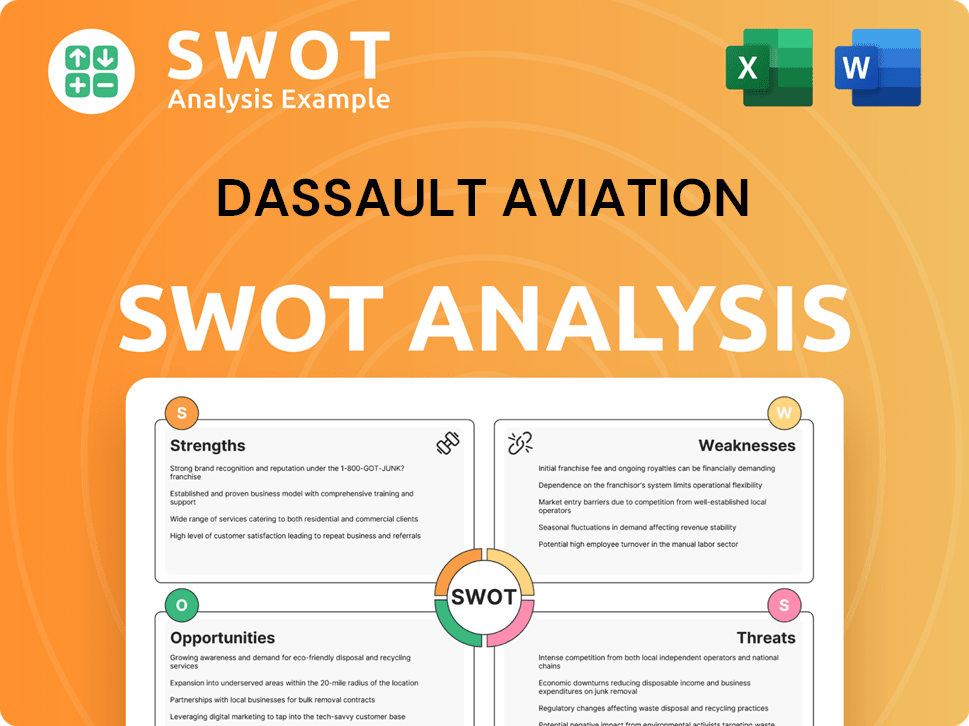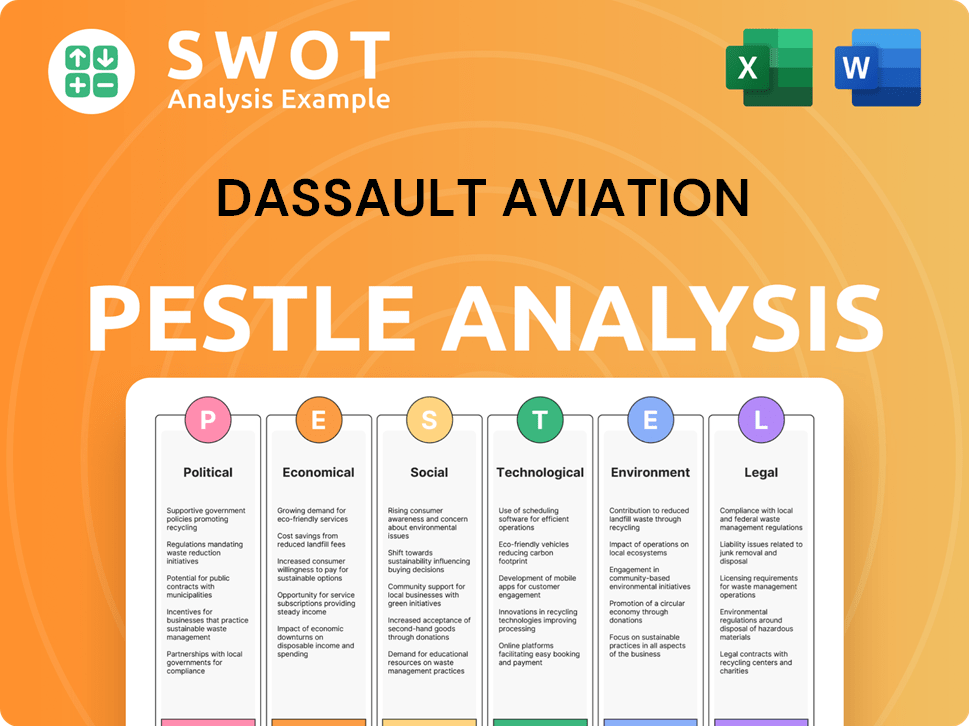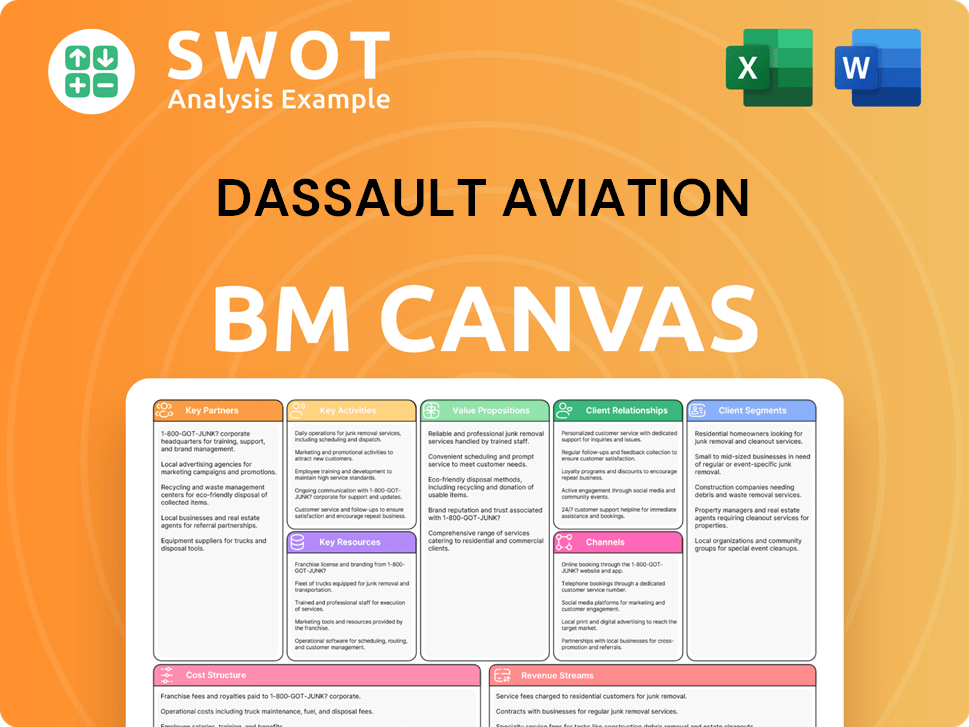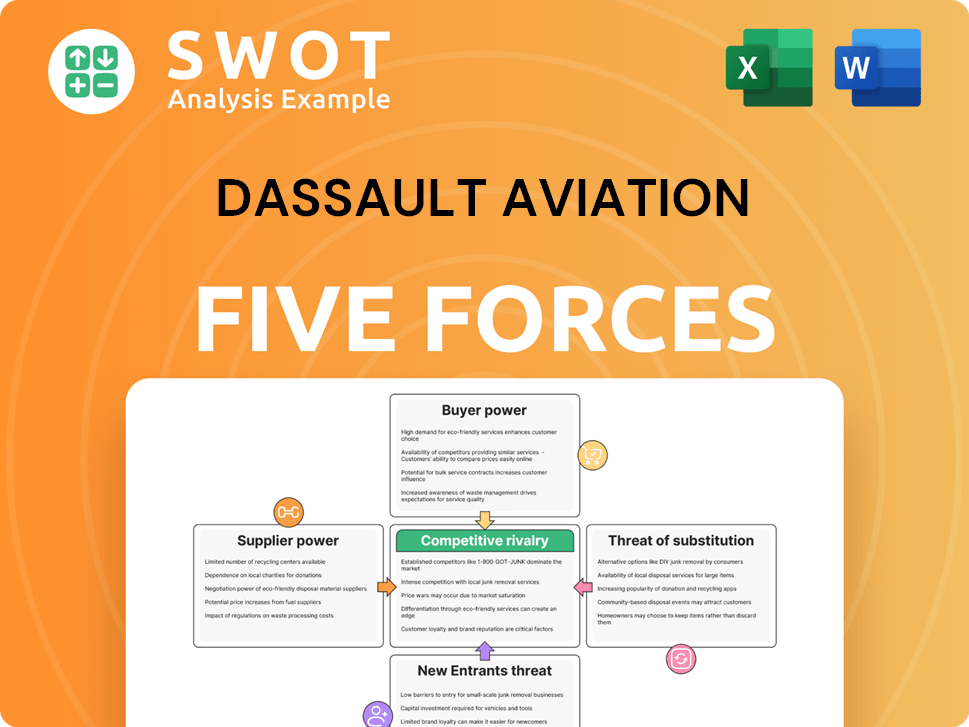Dassault Aviation Bundle
How has Dassault Aviation shaped the world of flight?
From its inception, Dassault Aviation, a prominent French aircraft manufacturer, has been synonymous with innovation and engineering excellence. Founded in 1929 by Marcel Bloch, later known as Marcel Dassault, the company quickly established itself as a pioneer in the burgeoning aviation industry. Its legacy includes iconic military aircraft and luxurious business jets, cementing its place as a global aerospace leader.

The Dassault Aviation SWOT Analysis reveals the company's strengths, weaknesses, opportunities, and threats within the dynamic aviation landscape. Dassault's commitment to cutting-edge technology is evident in its military aircraft, such as the Rafale fighter jet, and its renowned Falcon business jets. This exploration of Dassault's history will examine the key milestones, including the development of the Mirage series, and the challenges that have shaped this French aviation giant.
What is the Dassault Aviation Founding Story?
The story of Dassault Aviation began on January 20, 1929, when Marcel Bloch established the company. Bloch, a talented aeronautical engineer, saw an opportunity in the growing aviation industry. His vision was to create innovative aircraft designs that would set new standards for performance and utility.
The initial focus of the company was on designing and manufacturing military aircraft for the French Air Force. This strategic decision was crucial in the early days, as it provided a stable market and the necessary resources for growth. The company's first significant products included the MB.80 medical evacuation aircraft and the MB.120 colonial transport aircraft.
Marcel Bloch's personal funds and early contracts funded the company's beginnings. The name 'Dassault' was adopted after World War II, a pseudonym Bloch used during the French Resistance. This name change marked a fresh start and a continued dedication to national defense. The company's early growth was significantly shaped by the interwar period's emphasis on national security and technological advancement.
Dassault Aviation, a prominent French aircraft manufacturer, was founded by Marcel Bloch in 1929. Bloch, an aeronautical engineer, saw potential in the aviation industry.
- Marcel Bloch, later known as Marcel Dassault, used his engineering expertise to design innovative aircraft.
- The company initially focused on military aircraft, a strategic choice that provided early contracts and funding.
- The name 'Dassault' was adopted after World War II, symbolizing a new beginning and commitment to national defense.
- The interwar period's focus on national security and technological advancement significantly influenced the company's trajectory.
Dassault Aviation SWOT Analysis
- Complete SWOT Breakdown
- Fully Customizable
- Editable in Excel & Word
- Professional Formatting
- Investor-Ready Format

What Drove the Early Growth of Dassault Aviation?
The early growth of Dassault Aviation was marked by successful aircraft designs and strategic expansions. In the 1930s, the company gained prominence with military aircraft, establishing a strong reputation. Following World War II, Marcel Dassault re-established his company, focusing on innovative jet aircraft designs.
During the 1930s, Dassault, a French aircraft manufacturer, achieved early success with military aircraft. The Bloch MB.200 bomber and the Bloch MB.150 fighter series were critical for the French Air Force. These aircraft demonstrated the company’s ability to produce robust and effective designs.
The post-war era saw significant product launches, including the Ouragan, Mystère, and Etendard jet fighters. These aircraft secured major contracts with the French government and international clients. This period was crucial for Dassault's expansion.
Dassault expanded its team, bringing in more engineers and skilled workers to support jet aircraft manufacturing. The company diversified by launching its business jet division in the 1960s, with the Falcon series. The Falcon 20 was a commercial success.
The introduction of the Falcon series led to entry into the North American market. This strategic diversification balanced military contracts with commercial revenue streams. Leadership remained within the Dassault family, ensuring continuity of vision and strategy.
Dassault Aviation PESTLE Analysis
- Covers All 6 PESTLE Categories
- No Research Needed – Save Hours of Work
- Built by Experts, Trusted by Consultants
- Instant Download, Ready to Use
- 100% Editable, Fully Customizable

What are the key Milestones in Dassault Aviation history?
The Dassault Aviation company, a prominent French aircraft manufacturer, has a rich history marked by significant milestones in both military and business aviation. From its early days under the guidance of Marcel Dassault, the company has consistently pushed the boundaries of aerospace technology. This has led to the development of iconic aircraft that have shaped the aviation industry.
| Year | Milestone |
|---|---|
| 1936 | Foundation of the company by Marcel Bloch, later renamed Dassault Aviation. |
| 1950s-1970s | Development and success of the Mirage series, establishing Dassault as a key player in military aviation. |
| 1960s | Introduction of the Falcon business jet series, marking the company's entry into the business aviation market. |
| 1980s-2000s | Development and refinement of the Mirage 2000, solidifying its position in the global market. |
| 2000s-Present | The Rafale fighter jet enters service and gains international recognition, with significant export orders. |
| 2024 | Continued innovation in business jets with the Falcon 10X, and further international orders for the Rafale. |
The company's commitment to innovation is evident in its pioneering designs and technologies. The Dassault Falcon series, for example, has consistently introduced advancements in business aviation, such as fly-by-wire controls. Furthermore, the Rafale's advanced systems, including the SPECTRA electronic warfare system and the RBE2 AA radar, showcase Dassault's technological leadership.
The Falcon 7X was the first business jet to feature fly-by-wire controls, enhancing flight efficiency and pilot control.
The Rafale's RBE2 AA active electronically scanned array radar provides superior target detection and tracking capabilities.
The Rafale's SPECTRA electronic warfare system offers advanced protection against threats.
The upcoming Falcon 10X will feature advanced digital flight control systems, further enhancing flight performance and safety.
Dassault is investing in sustainable aviation solutions to address contemporary challenges.
The Falcon 10X is poised to offer the largest cabin in its class, setting a new standard for business jets.
Despite its successes, Dassault Aviation has faced several challenges. Intense competition from US manufacturers and navigating complex geopolitical landscapes for military sales have been significant hurdles. Market downturns in the business jet sector have also necessitated strategic adjustments.
The company faces strong competition from other global aircraft manufacturers, particularly in the business jet and military aircraft markets.
Securing military sales involves navigating complex geopolitical landscapes and international relations.
Economic downturns and fluctuations in the business jet market can impact sales and require strategic adaptations.
Continuous investment in research and development is crucial, requiring significant financial resources.
The company must continuously adapt its product offerings to meet evolving market demands and customer preferences.
Embracing digital transformation and integrating new technologies is essential for maintaining a competitive edge.
Dassault Aviation Business Model Canvas
- Complete 9-Block Business Model Canvas
- Effortlessly Communicate Your Business Strategy
- Investor-Ready BMC Format
- 100% Editable and Customizable
- Clear and Structured Layout

What is the Timeline of Key Events for Dassault Aviation?
The Dassault Aviation company, a prominent French aircraft manufacturer, has a rich history. Founded by Marcel Bloch in 1929 as Société des Avions Marcel Bloch, the company initially focused on military aircraft. Marcel Bloch later changed his name to Marcel Dassault in 1947, and the company was renamed. Over the decades, it has achieved significant milestones in both military and business aviation, solidifying its position in the aviation industry.
| Year | Key Event |
|---|---|
| 1929 | Marcel Bloch establishes the Société des Avions Marcel Bloch. |
| 1930s | Development of early military aircraft, including the MB.200 bomber. |
| 1947 | Marcel Bloch changes his name to Marcel Dassault; company renamed Dassault. |
| 1954 | First flight of the Mystère IV, a significant jet fighter. |
| 1963 | First flight of the Falcon 20, marking entry into the business jet market. |
| 1967 | First flight of the Mirage F1, a successful multirole fighter. |
| 1970s | Development and widespread export of the Mirage III and Mirage F1. |
| 1986 | First flight of the Rafale prototype. |
| 2001 | Rafale enters service with the French Navy. |
| 2013 | First flight of the Falcon 8X. |
| 2021 | Launch of the Falcon 10X program, aiming for entry into service around 2027. |
| 2024 | Continued international orders for the Rafale fighter jet, reinforcing its global presence. |
| 2025 | Focus on the development of the Future Combat Air System (FCAS) program, a collaborative European initiative. |
The Future Combat Air System (FCAS) is a major collaborative initiative. This program is designed to develop a next-generation air combat system. The FCAS program highlights Dassault Aviation's commitment to innovation.
The Falcon 10X program is a key element of Dassault's business aviation strategy. The Falcon 10X aims for entry into service around 2027. This demonstrates Dassault's focus on long-term growth.
The aviation industry is seeing increased demand for sustainable aviation. Advanced connectivity and autonomous capabilities are also key trends. These trends are likely to influence Dassault's future direction.
Analysts predict continued strong performance in the defense sector. Ongoing geopolitical tensions support this trend. The Rafale's proven capabilities are a key factor.
Dassault Aviation Porter's Five Forces Analysis
- Covers All 5 Competitive Forces in Detail
- Structured for Consultants, Students, and Founders
- 100% Editable in Microsoft Word & Excel
- Instant Digital Download – Use Immediately
- Compatible with Mac & PC – Fully Unlocked

Related Blogs
- What is Competitive Landscape of Dassault Aviation Company?
- What is Growth Strategy and Future Prospects of Dassault Aviation Company?
- How Does Dassault Aviation Company Work?
- What is Sales and Marketing Strategy of Dassault Aviation Company?
- What is Brief History of Dassault Aviation Company?
- Who Owns Dassault Aviation Company?
- What is Customer Demographics and Target Market of Dassault Aviation Company?
Disclaimer
All information, articles, and product details provided on this website are for general informational and educational purposes only. We do not claim any ownership over, nor do we intend to infringe upon, any trademarks, copyrights, logos, brand names, or other intellectual property mentioned or depicted on this site. Such intellectual property remains the property of its respective owners, and any references here are made solely for identification or informational purposes, without implying any affiliation, endorsement, or partnership.
We make no representations or warranties, express or implied, regarding the accuracy, completeness, or suitability of any content or products presented. Nothing on this website should be construed as legal, tax, investment, financial, medical, or other professional advice. In addition, no part of this site—including articles or product references—constitutes a solicitation, recommendation, endorsement, advertisement, or offer to buy or sell any securities, franchises, or other financial instruments, particularly in jurisdictions where such activity would be unlawful.
All content is of a general nature and may not address the specific circumstances of any individual or entity. It is not a substitute for professional advice or services. Any actions you take based on the information provided here are strictly at your own risk. You accept full responsibility for any decisions or outcomes arising from your use of this website and agree to release us from any liability in connection with your use of, or reliance upon, the content or products found herein.